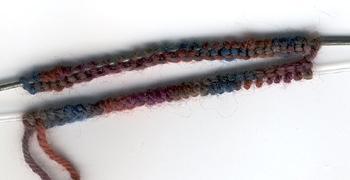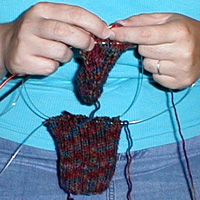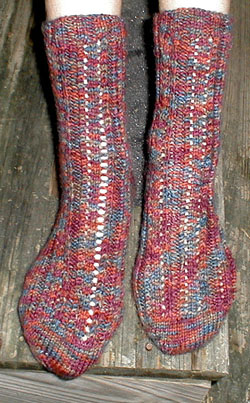
 by
Jenanne Hassler by
Jenanne Hassler

This
sock was designed to be knit on two circular needles.
The truly courageous will cast-on and work both
socks at the same time — oooh la-la!
After
joining your stitches, the first circular needle has
what will be your heel stitches, the second holds
the instep stitches. The lace pattern consists of
two rows, endlessly repeated over the instep stitches
only.
A
bit about the 2 socks/2 needles approach: You
will cast on the for the first sock, divide the stitches
between the needles, then cast on for the second sock
with your second skein of yarn and divide those stitches.
Both socks are worked simultaneously, working a round
on the first, then a round on the second.
When
it's time to turn the heel, you will work one sock
at a time until you've picked up the gusset stitches.
Then move on to the next sock [where you'll turn
the heel and pick up the gusset stitches]. At this
point you're back to working both socks in tandem
until the end.
|
|
Leg
Using
one needle and a long tail cast-on, CO 52[60] sts
for the first sock.
Transfer 26[30] of the sts to the second needle.
Going
back to the first needle, CO 52[60] sts for the second
sock with second skein of yarn.

Transfer
26[30] of the sts to the second needle. You've
just cast on two socks on two circular needles!

 Ribbing Ribbing
Being
careful not to twist your work, join and beg K2, P2
ribbing on first sock, using one needle at a time
[i.e., if the first needle is in your right hand,
the other end of that needle is in your left hand].
The join marks the beg of each rnd. Work the second
sock in the same way. You will work both socks the
simultaneously, going back and forth between them.
Continue ribbing for 1[1.5] inches.
Continue
ribbing over first needle and begin lace pattern across
stitches on second needle as follows:
Lace
Rnd
1: p 2[4], *k2tog, yo, k2, yo, k2tog, p 2* 3 times
total; p 0[2].
Rnd
2: p 0[2] * p2, k 6* 3 times total; p 2[4].
Cont
in this manner until sock leg measures 5[6] inches
or length desired.
 Heel Heel
Turn
your attention fully to the first sock:
Working
with the heel sts only [on the first needle]:
Row
1: * [Sl 1, k 1]; rep from * until end of row
Row
2: Sl 1, p until end of row
Rep
these two rows 15[17] times or until heel length desired.
Turn
Turn
the heel as foll [or use your favorite heel turn]:
Rnd
1: Sl 1, k 16[18], SSK, turn.
Rnd
2: Sl 1, p 8[9], p2tog, turn.
Rnd
3: S 1, k 8[9], SSK, turn
Repeat
rounds 2 and 3 until all stitches are k and end with
a k row.
 Gussets Gussets
Using
first needle, pick up 15[17] sts [using the sl st
along the edge of the heel flap]. Switch to second
needle, continue in lace patt across instep sts. Place
marker.
Pick up 15[17] sts [using the sl st along the edge
of the heel flap] with a separate "holder"
needle.
Work
heel and gusset on second sock.
Foot
As
you begin Round 1 for the first time, slip the stitches
on holder to the first needle. In this way you keep
the heel on the first needle and the instep on the
second.
Rnd
1: First needle: K1, SSK, K across until 3 sts
rem. K2tog, K1.
Second
needle: Cont in patt.
Rnd
2: Both needles: Cont in est patt.
Rep
rnds 1 and 2 until 52[60] sts remain [26[30] on each
needle].
Cont in est patt until foot measures 1.5 inches less
than desired length.
Toe
Rnd
1: K 1, SSK. K across until 3 sts rem. K2tog, k1.
Rnd
2: K all sts.
Rep
rnd 1 and 2 until 8 sts rem [4 sts on each needle].
Turn
socks inside out while on the needles [move them to
the cable section of each needle to make this easier].
Using 3-needle bind off, BO all sts.
|

Jenanne
Hassler is a knitter, a mother, a wife, a home educator,
a quilter, a blogger
and self employed.
She
still manages to find time each day to be bored out
of her skull. From this, designing was born.
|

